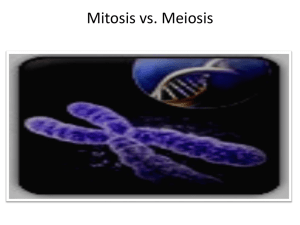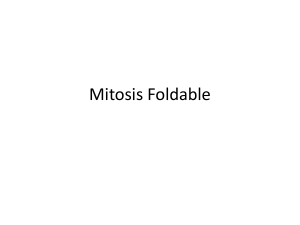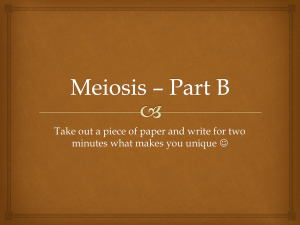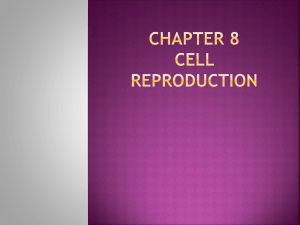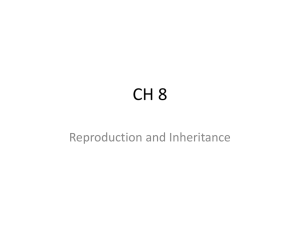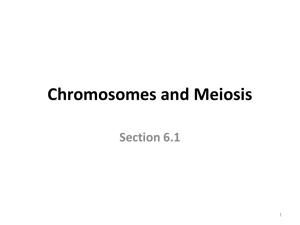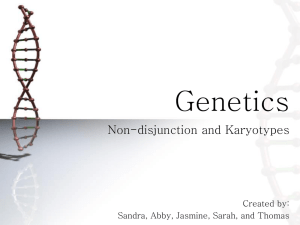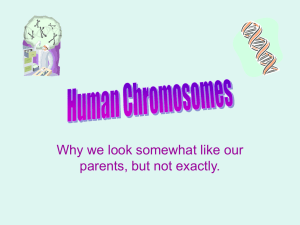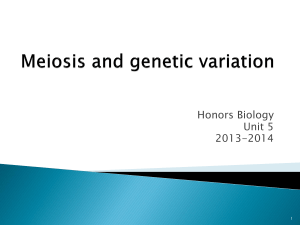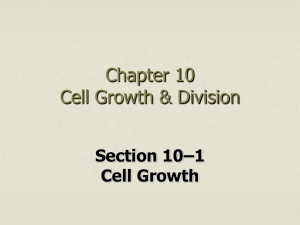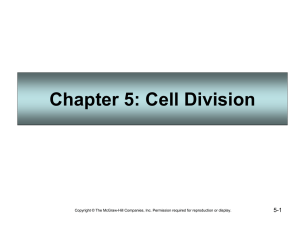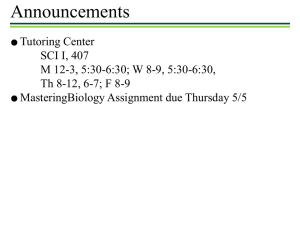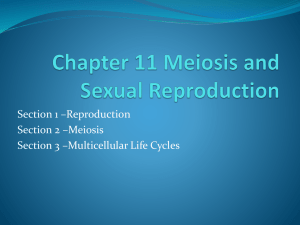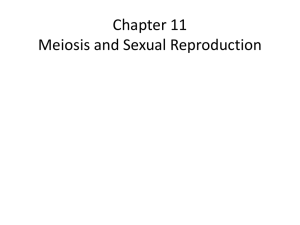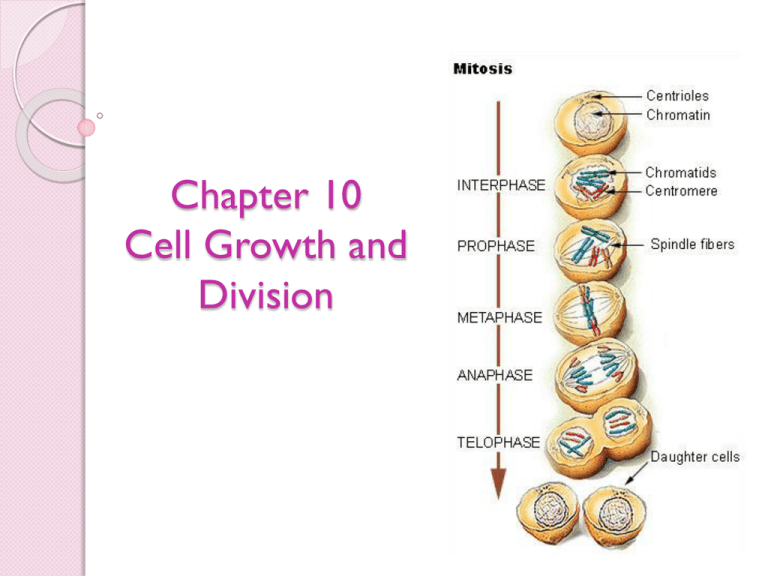
Chapter 10
Cell Growth and
Division
I. Cell Growth
A. When cells are NOT dividing, DNA is found
in the nucleus in the form of uncoiled
chromatin.
1. What does this look like in the cell? A
mass of genetic material that is spread
out; a bowl of spaghetti.
I. Cell Growth
2. When the cell is getting ready to
divide, chromosomes form as the DNA
wraps around histones.
I. Cell Growth
B. Chromosomes – carriers of genetic
information that is copied and passed to new
cells
1. Gene – section of DNA that controls
production of a protein; found on a
chromosome
I. Cell Growth
2. Structure of Chromosomes
a. Each chromosome
consists of two identical
halves. These halves are
known as sister
chromatids.
b. Joining the pair of
chromatids together is a
centromere. This holds
them together until they
separate at cell division.
I. Cell Growth
c. What does this look like in the cell?
I. Cell Growth
3. Chromosome Numbers
a. Each organism has a characteristic
number of chromosomes.
- Fruit flies = 8 chromosomes (4 pair)
- Adder’s Tongue Fern = 1, 262
chromosomes (631 pairs)
- Humans = 46 chromosomes (23
pairs)
I. Cell Growth
I. Cell Growth
C. Two types of Chromosomes
1. Sex Chromosomes – determine the sex
of an organism; humans have 2 of these
chromosomes (1 pair)
a. Male = XY, Female = XX
I. Cell Growth
2. Autosomes – the remaining body
chromosomes; humans have 44 of these.
They will “travel in pairs”, as homologous
chromosomes.
I. Cell Growth
3. This means you have 2 of every
chromosome, they carry genes for the
same traits, but they are NOT identical.
a. Where do they come from? You
receive 1 chromosome from each
parent!
b. Example: Chromosome 19 contains
genes for hair color. Mom’s #19
could have the “blonde” hair gene
and Dad’s #19 could the “brown”
hair gene.
I. Cell Growth
D. Chromosomes in Each Cell
1. Diploid – a cell containing 2 copies
of each chromosome (both
chromosomes in the homologous pair)
a. Abbreviated: 2N
b. Human example: skin cells,
muscle cells (any BODY cell), 2N
= 46
I. Cell Growth
2. Haploid – a cell containing 1 copy of
each chromosome
a. Abbreviated: N
b. Human example: sperm and
eggs cells (any SEX/gamete cell), N
=23
I. Cell Growth
E. Cell Size Limits
1. Organisms grow by producing more
cells.
a. Cell size is usually comparable
between a young and old animal; the
older animal just has more of them.
Hypotonic solution
H2O
Isotonic solution
Hypertonic solution
H2O
H2O
H2O
H2O
H2O
H2O
(a) Animal
cell
H2O
(b) Plant
cell
A
B
C
I. Cell Growth
2. Why can’t cells continually grow larger?
a. DNA “Overload” – it can no longer
meet all the cells needs/demands
I. Cell Growth
b. Exchanging materials
- Rate at which materials are
exchanged depends on the cell
membrane (surface area of the
cell).
- Rate at which materials are used
(oxygen, water) or produced (waste)
depends on the volume of the cell.
I. Cell Growth
c. As the length of the cell increases, the
volume increases faster than the surface
area.
d. It is hard for the cells to keep up with
moving materials and wastes in and out, so
the cell divides.
II. Cell Division
A. Cell division performed by prokaryotes
is a simple process. Two identical cells are
created from one cell through the process
of binary fission.
1. Steps of Binary Fission
a. Chromosome attached to
inside of cell membrane makes a
copy of itself.
II. Cell Division
b. Cell begins to grow until it is
about two times the size of
parent cell.
c. A new cell wall forms
between the two
chromosomes; cell splits into
two new cells.
II. Cell Division
B. Two Types of Cell Division in Eukaryotes
1. Mitosis – cell division that produces
body cells identical to the original
parent cell (diploid)
a. Examples of cells that do this:
skin, muscle, heart
2. Meiosis – cell division that produces
gametes (sex cells) with half the
number of chromosomes as the parent
cell (haploid)
a. Examples of cells that do this:
sperm and egg; GAMETES ONLY
II. Cell Division
C. Cell Cycle – sequences of growth and
division of the cell
1. Three Steps of the Cell Cycle
a. Interphase (most time spent
here)
b. Mitosis
c. Cytokinesis
II. Cell Division
How long does it take for a cell to go
through one cell cycle?
It all depends on the cell.
A human liver cell, for
example, completes one cell
cycle in about 22 hours, as
shown in the graph.
II. Cell Division
D. Cell Cycle in Detail
1. Interphase - time when the cell is
NOT dividing
a. Three Phases of Interphase
- G1 - cell grows, makes
organelles
- S - DNA copied
(synthesized)
- G2 - cell makes centrioles;
normal metabolism; preparing
to divide
II. Cell Division
2. Mitosis - dividing of the cell’s
nucleus
FOUR PHASES OF MITOSIS
a. Prophase
b. Metaphase
c. Anaphase
d. Telophase
II. Cell Division
a. Four Phase of Mitosis
- Prophase - longest phase of
mitosis
Chromatin coils into visible chromosomes (sister
chromatids)
Nuclear envelope/membrane starts to disappear
Spindle fibers appear from centrioles (animal cells only)
II. Cell Division
- Metaphase - shortest phase of mitosis
Spindles attach and move
chromosomes to line up along the
equator (middle) of the cell
II. Cell Division
- Anaphase Chromosomes are pulled apart at
the centromere by spindles and
separated into sister chromatids
II. Cell Division
- Telophase Sister chromatids reach opposite poles
(sides of the cell)
Spindles disappear
Nuclear envelopes/membranes
reappear
Cell begins to split into 2 new cells
II. Cell Division
- Cytokinesis - dividing of the cell’s
cytoplasm, forming two new cells
Animal cells: 2 new cells are separated
by the cytoplasm “pinching in”
II. Cell Division
Plant cells: 2 new cells separated by a cell
plate that helps form the cell walls
II. Cell Division
- Cytokinesis -
II. Cell Division
E. Meiosis
1. Meiosis - Cell division that produces
gametes with half the number of
chromosomes as the parent cell (haploid)
a. 2 separate cell divisions: meiosis I
and meiosis II
- Interphase and cytokinesis
occur with both divisions
II. Cell Division
b. Meiosis starts with 1 diploid cell
and ends with 4 haploid cells; Each
gamete has half the number of
chromosomes as a diploid cell.
1 diploid cell with
4 chromosomes
4 haploid cells with
2 chromosomes each
II. Cell Division
F. Steps of Meiosis
1. MEIOSIS I
a. Prophase I DNA coils into tetrads (pair of homologous
chromosomes)
Spindles appear
Nuclear envelope/membrane disappears
Crossing over occurs - DNA is swapped between
chromosomes in a pair
II. Cell Division
b. Metaphase I Tetrads are moved by the spindles and line up
along the middle/equator of the cell.
II. Cell Division
c. Anaphase I Tetrads pulled apart by the spindles and
separated into chromosomes
Chromosomes begin moving to opposite ends
of the cell
II. Cell Division
d. Telophase I Chromosomes reach opposite sides of the cell
Spindle disappears
Nuclear envelope/membrane reappears
Cytokinesis occurs after this step, forming two
new cells, which then go through interphase
again
II. Cell Division
• Meiosis II--has 4 stages, PMAT II
•Each stage--occurs just like the stages of mitosis
Prophase II
Metaphase II
Anaphase II
Telophase II
II. Cell Division
2. MEIOSIS II
a. Prophase II -
Spindle appear in each of the 2 new cells
Nuclear envelopes/membranes disappears
II. Cell Division
b. Metaphase II Sister chromatids line up in the middle/equator
of the cell.
II. Cell Division
c. Anaphase II -
Spindles split centromeres and sister
chromatids separate
Chromatids start to move to opposite ends of
the cell
II. Cell Division
d. Telophase II Sister chromatids (haploid) reach opposite ends
of the cell
Spindles disappear
Nuclear envelopes/membranes appear
Cytokinesis follows this step forming four new
cells
II. Cell Division
G. Soooooooooooo, what happens after
meiosis?
1. Sexual Reproduction - production and
combination of gametes
a. Fertilization- fusion of male and
female gametes to form zygote
Zygote - diploid cell (2 of each chromosome)
http://video.sciencemag.org/VideoLab/2127025888001/1/medicine
Comparison of Types of Division
Mitosis
Meiosis
Occurs in most body cells Occurs only in sex cells
One division
Two divisions
One cell makes 2 diploid
cells
Identical to the parent
One cell makes 4 haploid
cells
Different from parent




